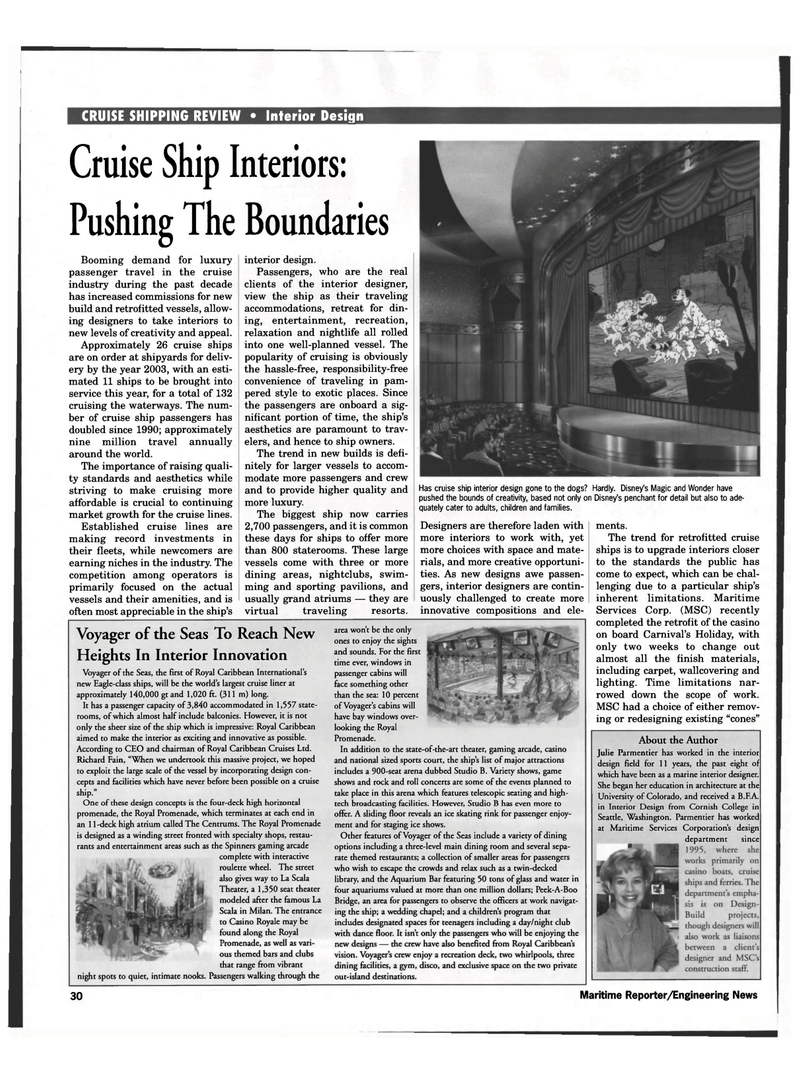
Page 33: of Maritime Reporter Magazine (February 1999)
Read this page in Pdf, Flash or Html5 edition of February 1999 Maritime Reporter Magazine
CRUISE SHIPPING REVIEW • Interior Design
About the Author
Julie Parmentier has worked in the interior design field for 11 years, the past eight of which have been as a marine interior designer.
She began her education in architecture at the
University of Colorado, and received a B.F.A. in Interior Design from Cornish College in
Seattle, Washington. Parmentier has worked at Maritime Services Corporation's design department since
Voyager of the Seas To Reach New
Heights In Interior Innovation
Voyager of the Seas, the first of Royal Caribbean International's new Eagle-class ships, will be the world's largest cruise liner at approximately 140,000 gt and 1,020 ft. (311 m) long.
It has a passenger capacity of 3,840 accommodated in 1,557 state- rooms, of which almost half include balconies. However, it is not only the sheer size of the ship which is impressive: Royal Caribbean aimed to make the interior as exciting and innovative as possible.
According to CEO and chairman of Royal Caribbean Cruises Ltd.
Richard Fain, "When we undertook this massive project, we hoped to exploit the large scale of the vessel by incorporating design con- cepts and facilities which have never before been possible on a cruise ship."
One of these design concepts is the four-deck high horizontal promenade, the Royal Promenade, which terminates at each end in an 11-deck high atrium called The Centrums. The Royal Promenade is designed as a winding street fronted with specialty shops, restau- rants and entertainment areas such as the Spinners gaming arcade complete with interactive roulette wheel. The street also gives way to La Scala
Theater, a 1,350 seat theater modeled after the famous La
Scala in Milan. The entrance to Casino Royale may be found along the Royal
Promenade, as well as vari- ous themed bars and clubs that range from vibrant night spots to quiet, intimate nooks. Passengers walking through the area won't be the only ones to enjoy the sights and sounds. For the first time ever, windows in passenger cabins will face something other than the sea: 10 percent of Voyager's cabins will have bay windows over- looking the Royal
Promenade.
In addition to the state-of-the-art theater, gaming arcade, casino and national sized sports court, the ship's list of major attractions includes a 900-seat arena dubbed Studio B. Variety shows, game shows and rock and roll concerts are some of the events planned to take place in this arena which features telescopic seating and high- tech broadcasting facilities. However, Studio B has even more to offer. A sliding floor reveals an ice skating rink for passenger enjoy- ment and for staging ice shows.
Other features of Voyager of the Seas include a variety of dining options including a three-level main dining room and several sepa- rate themed restaurants; a collection of smaller areas for passengers who wish to escape the crowds and relax such as a twin-decked library, and the Aquarium Bar featuring 50 tons of glass and water in four aquariums valued at more than one million dollars; Peek-A-Boo
Bridge, an area for passengers to observe the officers at work navigat- ing the ship; a wedding chapel; and a children's program that includes designated spaces for teenagers including a day/night club with dance floor. It isn't only the passengers who will be enjoying the new designs — the crew have also benefited from Royal Caribbean's vision. Voyager's crew enjoy a recreation deck, two whirlpools, three dining facilities, a gym, disco, and exclusive space on the two private out-island destinations.
Cruise Ship Interiors:
Pushing The Boundaries
Booming demand for luxury passenger travel in the cruise industry during the past decade has increased commissions for new build and retrofitted vessels, allow- ing designers to take interiors to new levels of creativity and appeal.
Approximately 26 cruise ships are on order at shipyards for deliv- ery by the year 2003, with an esti- mated 11 ships to be brought into service this year, for a total of 132 cruising the waterways. The num- ber of cruise ship passengers has doubled since 1990; approximately nine million travel annually around the world.
The importance of raising quali- ty standards and aesthetics while striving to make cruising more affordable is crucial to continuing market growth for the cruise lines.
Established cruise lines are making record investments in their fleets, while newcomers are earning niches in the industry. The competition among operators is primarily focused on the actual vessels and their amenities, and is often most appreciable in the ship's interior design.
Passengers, who are the real clients of the interior designer, view the ship as their traveling accommodations, retreat for din- ing, entertainment, recreation, relaxation and nightlife all rolled into one well-planned vessel. The popularity of cruising is obviously the hassle-free, responsibility-free convenience of traveling in pam- pered style to exotic places. Since the passengers are onboard a sig- nificant portion of time, the ship's aesthetics are paramount to trav- elers, and hence to ship owners.
The trend in new builds is defi- nitely for larger vessels to accom- modate more passengers and crew and to provide higher quality and more luxury.
The biggest ship now carries 2,700 passengers, and it is common these days for ships to offer more than 800 staterooms. These large vessels come with three or more dining areas, nightclubs, swim- ming and sporting pavilions, and usually grand atriums — they are virtual traveling resorts.
Has cruise ship interior design gone to the dogs? Hardly. Disney's Magic and Wonder have pushed the bounds of creativity, based not only on Disney's penchant for detail but also to ade- quately cater to adults, children and families.
Designers are therefore laden with more interiors to work with, yet more choices with space and mate- rials, and more creative opportuni- ties. As new designs awe passen- gers, interior designers are contin- uously challenged to create more innovative compositions and ele- ments.
The trend for retrofitted cruise ships is to upgrade interiors closer to the standards the public has come to expect, which can be chal- lenging due to a particular ship's inherent limitations. Maritime
Services Corp. (MSC) recently completed the retrofit of the casino on board Carnival's Holiday, with only two weeks to change out almost all the finish materials, including carpet, wallcovering and lighting. Time limitations nar- rowed down the scope of work.
MSC had a choice of either remov- ing or redesigning existing "cones" 30 Maritime Reporter/Engineering News

 32
32

 34
34
